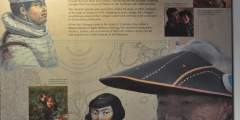Unalaska Museums & Cultural Centers
The mystique of Unalaska begins with its remoteness, and continues with its dramatic landscape, its abundant flora and fauna, and its complex history that continues to impact residents today.
Signs of this history are present everywhere. From its name (Unalaska or Dutch Harbor?) to the prominent Russian orthodox church to left-over pillboxes and gun placements from World War II. What happened here? Why do people live here, far off in this rugged land of storms and biting winds?
To put these clues in context and answer these questions, every visitor to Unalaska should spend time at the Museum of the Aleutians and the Aleutian World War II Visitor Center. Both are modern, well-designed museums with interactive displays, videos, and interpretive panels that engage visitors in the Unalaska story.
The Museum of the Aleutians provides an overview of life on the Aleutian Chain, including Unangan culture, the natural world of the islands and World War II. The Aleutian World War II Visitor Center is located in an old WWII building and is focused on the 1940s and Unalaska’s strategic role during the war.
Entrance fees are low and the museums are easy to go through in a couple of hours. You’ll walk out with a deeper understanding of this amazing place and its people - one that may encourage you to try and stay here just a bit longer.
Show Map
Museums, Cultural Centers
Spend just a few hours at the Museum of the Aleutians and you’ll walk away with a broad understanding of this remote island chain, its hardy and inventive Unangan people, and its compelling World War II history.
Whether or not you’re a World War II scholar, the story of the Aleutian Islands’ role in the second great war is fascinating. The military buildup, the battles, the removal and eventual return of Aleut residents. It’s all detailed at the Aleutian World War II Visitor’s Center, located in an historic Aerology Operations Building that has been renovated to its original 1940s-style façade.



